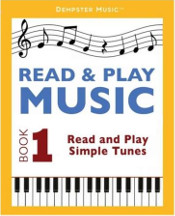Read and Play Music is a series of online courses for learning to read and play music on the piano. It seems most suitable for independent study, so potential students should be able to read and follow instructions on their own. However, students as young as third-grade level should be able to complete the courses with parental assistance.
Lessons are delivered online and sometimes include links to videos that should be viewed, audio files for students to hear how a line or lines of music should sound, and audio files for a recorded musical piece such as “Ode to Joy.” The linked files can also be accessed directly from the page where you access all of the lessons, so you can easily click on the supplemental files when you want to use them. Students will often be playing music from written music within the lesson pages.
Even though these are multi-media courses, they are titled like traditional piano courses: Book 1, Book 2, Book 3, and Book 4. However, only Book 1 and Book 2 are available thus far. My review focuses primarily on Book 1.
The pacing and style of the course make it accessible for a broad age range, including adults. The progression is gradual which makes it very manageable for younger students as well as for older students with no knowledge of music theory. For example, students will be playing only on the white keys through the first three courses. The first course teaches students how to determine which notes in the music correlate with keys on the keyboard and how to play with accurate timing. Music theory is introduced gradually as well.
Through the lessons of Book 1, students practice very short pieces of music and parts of larger pieces. When they complete the 22 lessons, they should work through the 25-page Book 1 Tunes that is included as part of the course. It has a number of old familiar songs written with music for only one hand, and tunes in this book shift from easy to more difficult. After students have mastered most, if not all, of the tunes in this book, they should be well prepared to move on to Book 2. Book 2 teaches how to play notes with the left hand, then how to play with both hands simultaneously. It also introduces simple harmonies created by playing multiple notes at a time.
The course instructor, David Dempster, provides thorough instruction along with lots of repetition and practice through multi-sensory learning methods. For example, he teaches students to recognize musical notes by their letter names as well as when written in musical notation. He models how to play on the video segments. He has students write their own musical notation to reinforce the location of each note on the music staff. He has them play and say the letter names of the notes they are playing. And he sometimes provides audio clips so students can listen as well. Dempster’s Scottish accent is a delightful added bonus.
While music from a few well-known Christian hymns, such as "When the Saints Go Marching In," is included, this isn't really a Christian program.
Dempster’s goal is to provide a foundation in music theory using the piano since it is easier to see the location of notes on a keyboard than on other instruments. This foundation might well be a springboard for learning other instruments in the future.
Read and Play Music seems to be one of the gentlest approaches I’ve encountered for learning music theory and piano. If students follow Dempster’s instructions, they can’t help but be successful.









